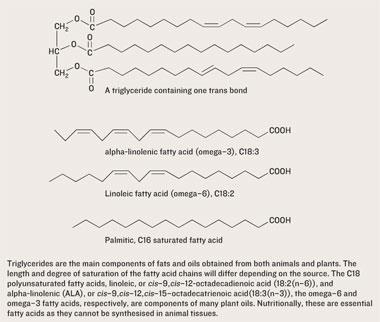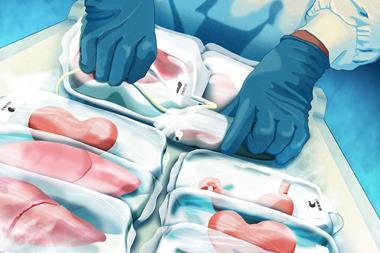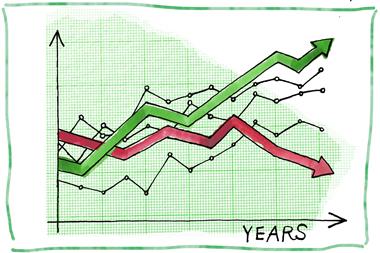Eating too much trans fat is bad for your health and manufacturers are working to lower the levels in foods. Fiona Case explores some of the techniques that chemists, biologists and engineers have developed
Eating too much trans fat is bad for your health and manufacturers are working to lower the levels in foods. Fiona Case explores some of the techniques that chemists, biologists and engineers have developed
Fatty acids containing trans double bonds in their alkane chains (trans fats) are bad for you. In the early 1990s health problems related to eating trans fat were first brought to light by researchers at Harvard Medical School, US, through the Nurses’ Health Study. Subsequent research linked eating trans fat to an increased risk for both heart disease and type 2 diabetes.

In a 1999 report, published jointly with the Wageningen Centre for Food Sciences in the Netherlands, the researchers estimated that if trans fats were replaced by unsaturated vegetable oils, at least 30 000 premature deaths from coronary heart disease could be prevented each year in the US alone.
The Danish Nutrition Council (DNC) has recently completed a study on nutrition for pregnant women and advises Danish women to avoid food items likely to contain trans fat when they travel (within Denmark the trans fat content of food is limited by legislation). ’I am very concerned about this issue,’ comments Harald Hansen, DNC vice chairman.
Although a small percentage of fats from animal sources (milk, butter, lard, etc) contain trans double bonds, the vast majority of trans fatty acids in a modern diet come from the partial hydrogenation and ’deodorising’ of vegetable oils. The deodorising, bleaching, solvent extraction and partial hydrogenation of liquid frying oils improve their ’fry life’ and the shelf life of products made from them.
Further hydrogenation, usually carried out with hydrogen gas and a nickel catalyst, creates a partially saturated material that is able to crystallise - resulting in a crisper biscuit or doughnut, a more stable bakery confection, or a cake with a longer shelf life. Using partial hydrogenation you can tailor your fat for particular applications.
Partially hydrogenated vegetable oils were seen as health promoting products when they were first introduced.
Hard animal fats such as lard and butter were traditionally used in baking (particularly in Northern European cuisines) - but they would go rancid if they were stored at room temperature. Proctor and Gamble, Cincinnati, US, developed a method for hardening readily-available liquid vegetable oils and introduced Crisco shortening in 1911. The resulting more stable material was seen as a major step forward.
Saturated fats and heart disease
By the mid 20th century medical experts had became concerned about links between high consumption of saturated fats and heart disease. Recipes using the less saturated Crisco oil (introduced in 1960 and again the product of partial hydrogenation) were promoted in books and magazines. Margarine made from partially hydrogenated vegetable oils was seen as the healthy alternative to butter.
Unfortunately most partial hydrogenation was (and still is) accomplished under conditions that isomerise double bonds in the hydrocarbon chains - leading to a high percentage of trans fat in the final product (40 per cent trans is not uncommon). The isomerisation of cis double bonds in linoleic and linolenic fatty acids also destroys their activity as essential nutrients. The healthy alternatives were not as healthy as they had seemed.
Why are trans fats bad for you? The mechanism is still a subject of debate. It seems unlikely that a trans double bond would cause problems in the normal metabolism of fats for energy. Indeed, cis double bonds are isomerised to trans as unsaturated fatty acids are disassembled by repeated oxidation and cleavage of the Calpha-Cbeta bond to create acetate units (and, by the time combustion to CO2 is complete, almost 10 000 kJ/mol - fat is a very good source of energy!).
Problems might arise as triglyceride aggregates circulate in the blood stream waiting to be called to action in hungry liver, heart, or muscle cells; or as they are stored for future use. Trans fat increases blood levels of low density lipoprotein (LDL), ’bad’ cholesterol, while lowering levels of high density lipoprotein (HDL), known as ’good’ cholesterol; and this appears most problematic for people with high fat diets.
Chemical structures of fats

Reformulated fats
Some of the top-tier food manufacturers responded quickly to public concerns about trans fat and started reformulating their products. Others responded when challenged by consumer groups. Many of the better known packaged and snack foods are now ’trans fat free’ (below the trans threshold stipulated, per serving, for that particular country - it’s not really possible to create a product that has zero per cent trans fats), or available in low-trans varieties.
In most cases this has been achieved by replacing partially hydrogenated oils with oils that naturally, or as a result of transesterification, have the desired fatty acid distribution and physical properties. For example, including fats with large percentages of saturated fatty acids will generally result in a harder, higher melting point, material.
Government health bodies around the world have issued warnings and advice about trans fat. A few countries have already introduced legislative responses to the trans fat issue, and others are considering action - either limits or labelling laws.
In March 2003, Denmark became the first country to place strict limits on trans fats in processed foods. The Canadian food industry will have to adhere to new food labelling requirements, including labelling trans fat levels, by the end of this year.
Lobbying for labelling
In the US, trans fat labelling will be required from January 2006. It has been suggested that the slow progress of trans fat legislation in the US was the result of successful lobbying by the edible-oils industry. While this might be partially true, the US does face a greater challenge in reducing public consumption of trans fats.
The US diet was (and to a large extent remains), high in trans fatty acids. While other parts of the world consume vegetable oils from a wide range of sources - palm, cottonseed, canola, peanut, sunflower, coconut, and others - the vast majority of edible-oil used in the US comes from just one source - the soya bean. Oils and fats used for different applications such as baking, frying and confectionaries are generated from the liquid soya bean oil by varying the degree of hydrogenation.
Raising the trans fat issue in the US public consciousness, and the prospect of US trans fat labelling in January 2006, has greased the wheels for a number of innovative processes that will allow food manufacturers to continue consuming the soya bean industry’s huge output, while satisfying their customers with low-trans products.
Some of these new processes will almost certainly be adopted by the manufacturers and processors of other oils, leading to a wider range of low-trans options.
Alternative to solvent extraction
Physically extruded and expelled (E-E) soya bean oil is now available as an alternative to solvent extracted and partially hydrogenated soya bean frying oil.
The E-E oils are very low trans. They retain the roughly 6.5-8 per cent linolenic acid found in soya bean oil, taste better and, surprisingly, they last longer (linolenic acid was long considered the source of oxidative deterioration of soya bean oil - justifying its removal in the traditional processes).
One approach to create higher melting point fats is to fully hydrogenate soya bean oil - remove all the double bonds - and then carry out an intermolecular transesterification with unmodified oil, referred to as interesterification.
Interesterification swaps the fatty acids attached to the glycerol part creating low trans oils with tailored properties, although with an increase in saturated fat relative to the unmodified vegetable oil. This technology is highly developed in Europe and is used to prepare a wide variety of margarines, shortenings and baking fats.
Interesterification with enzymes
Archer Daniels Midland (ADM), one of the world’s largest agricultural processors of soya beans, recently pioneered a new approach to interesterification using a lipase enzyme. This rearranges the fatty acids in the 1- and 3-positions of triglyceride molecules and gives greater control over the process. ADM now supplies a range of trans free soya bean oil margarines.
It is also possible to develop new genetic varieties of soya bean - with different distributions of fatty acids - using biotechnology or conventional plant breeding. These might already have the physical properties needed for particular food applications, or could be more resistant to isomerisation during partial hydrogenation.
Another approach is to improve the partial hydrogenation process to reduce cis-trans isomerisation. Technology company Engelhard is studying a number of new catalyst systems, including precious metal catalysts. ’Our research shows that using these catalysts in a lower temperature hydrogenation process can reduce trans double bond generation to as low as two per cent,’ claimed Annemarie Beers, a research chemist with Engelhard De Meern, in the Netherlands, at the American Oil Chemists Society meeting in Salt Lake City, US, in May this year.
’More than 95 per cent of the catalyst material can be recovered and re-used, making this an economic, one-step replacement for the current process,’ she says. The company hopes to launch a commercial product by the end of the year.
H?rr?d Research in Sweden is developing a system where butane is added to the oil and hydrogen to create a homogeneous near- or supercritical mixture. Under these conditions extremely high hydrogenation rates are reached and the product contains only small amounts of trans fatty acids.
Hydrogenating soya bean oil
’Hydrogenation of soya bean oil is one very interesting application of supercritical fluid processing,’ says Magnus H?rr?d, chief executive officer of the company. ’We aim to hydrogenate soya bean oil in such a way that the 18:3 fatty acids are less than two per cent, while the trans is below five per cent. The trans should of course be as low as possible, but with five per cent trans in the oil the fried products will contain sufficiently small amounts of trans fatty acids that they could be labelled as trans-free according to the US rules,’ he explains.
These processes can reduce the trans fatty acids, while avoiding formation of saturated fatty acids. ’Together with catalyst companies we hope to reduce the trans even further. I hope that the first commercial plant for hydrogenation of edible oil under single phase conditions can be in operation in a few years.’
Paul Wassell, senior application technologist for Danisco, Denmark, advocates a different approach to formulating trans-free products. ’Manufacturers should be trying to solve the real problem - how to create low trans fat foods - rather than trying to create an oil with the same viscosity or percent solids as the partially hydrogenated material they are replacing,’ he says.
Reformulation using liquid oils (such a soya bean oil) and emulsifying agents (such as the mono-glyceride and surfactant mixtures developed by Danisco), can create cake batter that spreads well in the tin, cookies that are soft or crisp (depending on your cultural preference) and tortillas that are pliable, he claims.
Trans fatty acids in foods from US supermarkets
Product group Trans fat (g/100g fat)
Bread, cake and related products 0.0 - 48.8
Margarines 14.9 - 27.7
Vegetable oils and shortenings 0.0 - 13.2
Salad dressings and mayonnaises 0.0 - 2.2
Dry breakfast cereals 0.0 - 2.0
Destabilised protein
Emulsification can prevent oil from migrating to the food surface and giving a greasy feel to the product. It also prevents oil interacting with the proteins in applications like cake mixes. This is important since liquid oil destabilises protein, preventing stabilisation of air bubbles in the mixture. ’Try creating a meringue from sugar and egg whites in the presence of even a drop of liquid oil, and you will see the strength of this effect,’ comments Wassell.
In the short term it seems likely that in countries where there is no requirement to cut trans fats, many foods, cheaper ones in particular, will remain relatively high in trans fat. In all parts of the world the switch to trans-free or low trans might come initially at the price of higher saturated fat content.
New fat reduction technology
In future, as new technologies for hydrogenation using supercritical fluids or precious metal catalysts are adopted, or products are reformulated using emulsifiers, or new varieties of plants are bred, we may again be able to enjoy the benefits of partially hydrogenated oils without the trans fat.
But, of course, the best way to stay healthy is to keep your intake of fats within the dietary limits recommended by governments and health agencies.
This may involve increasing your intake of essential fatty acids and decreasing intake of saturated fats but it should certainly include reducing trans fatty acids wherever possible.
Fiona Case is a freelance science writer based in Vermont, US
Further Reading
- Trans fats alternatives, Edited by Dharma Kodali and Gary List, AOCS Press, Champaign Illinois, US, 2005






No comments yet